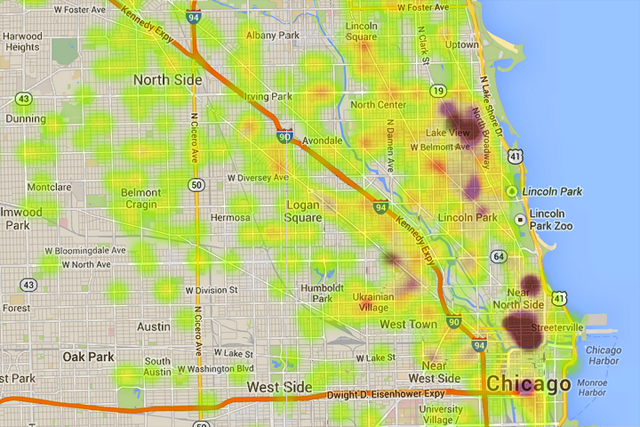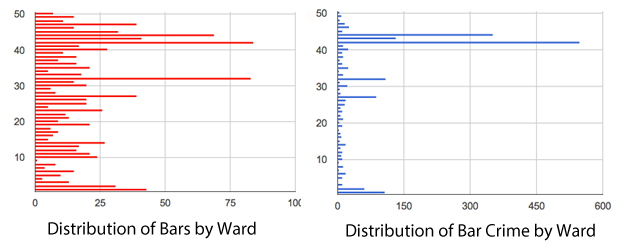Do Bars Cause 'Douche Vortices?'
By Melissa McEwen in News on May 9, 2014 7:30PM

Bar crime heatmap subtracted from tavern licenses heatmap. Purple spots = high concentration of bar crime and taverns. Red spots = high concentration of taverns without high concentration of crime.
“So it’s just a map of places that have a lot of bars in Chicago?” one commenter quipped on the so-called Douche vortex map, a heatmap generated by data on crimes committed in bars. What if this is true? What if Chicagoans can’t be trusted with booze?
It was a disheartening prospect, especially considering the resurgence of remnants of Chicago’s Old Temperance societies that guard many neighborhoods against new bars through an arcane codex of anti-booze legislation. I had always thought they were keeping away really cool new bars like Forbidden Root. Maybe they were merely valiantly guarding against the spread of the dreaded “Douche Vortices”, which sadly they associate with all bars.
The “douche vortex” is a humorous concept, but the maps are maps of crime and not all areas dense with bars are dense with crime. I downloaded all the business licenses for taverns in the supposed douche-vortex areas (this includes what we think of as bars, but not restaurants that serve alcohol) and heatmapped them. I subtracted the bar crime heatmap from those, and thankfully some bar-rich areas still remained.
The maps also show that a “douche vortex” can be dismantled. The area around the Congress Theater in Logan Square was pretty red with crime, but the neighborhood fought to revoke their license and the hotspot has now disappeared. Neighborhoods can rid their environment of crime-causing bars by getting them declared a public nuisance or having their liquor licenses revoked. But it’s a long process and it’s understandable why some neighborhoods would find it a lot easier just to prevent bars from opening in the first place.
The Mayors Daley were aggressive about closing down problem bars, but license revocations have slowed down since. There were 11 license revocations in 2013, back down to the level before the Daley era in 1988. In 1989, Richard M. Daley’s first year, 49 licenses were revoked.
Another factor is the number of bars overall in Chicago has declined. There is a large patchwork of dry districts and liquor moratoria all over the city. A lot of drinking has shifted towards “incidental activity” in restaurants.
Still, the maps show that not all bar hotspots are also crime hotspots. Some red dots that emerged on the West and North include Ukrainian Village, Bucktown, Lincoln Square, Irving Park, Andersonville, The South Loop, Edgewater, Jefferson Park, Norwood Park and Rogers Park. You won’t have trouble finding a bar in these areas.

Bar crime by ward vs. tavern licenses by ward. Bars are everywhere in Chicago, but crimes in bars are concentrated in a few areas.
It’s too bad that crime gives bars, and some areas, a bad name. Data shows that certain types of bars, like dance clubs, are associated with more crime. Some cities have also banned bottle service to try to fight bar-related crime. Others, including advocates of Forbidden Root, argue that some kinds of bars like those focusing on craft beer can actually be a deterrent to crime, fostering a more serene form of drinking. Forbidden Root ultimately was able to gain neighborhood support and should open this year.
The process that Forbidden Root had to go through was arduous for a new small business, but it also showed the importance of community engagement and how it can shape drinking habits and patterns. As more people invest in their communities and settle down in the city to raise families, an emerging demographic pattern in cities, it’s possible many of the “douche vortices” will disappear. I suspect areas like Lincoln Park will have more taverns friendly for families and fewer that are full of people getting totally wasted. The conflict in the movie Neighbors between rowdy bros and stroller-pushers will play out in real life. Then the topic of conversation will become babies in bars rather than brawls in bars.
Ultimately bars don't cause crime, assholes in bars cause crime.